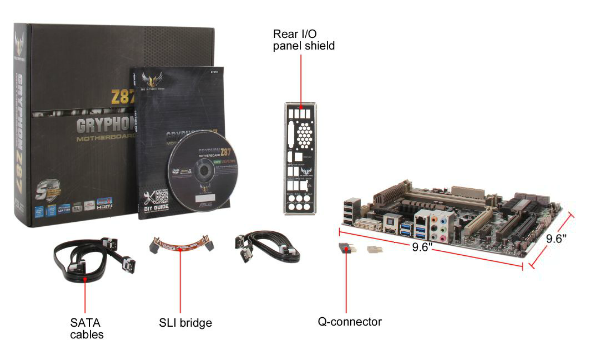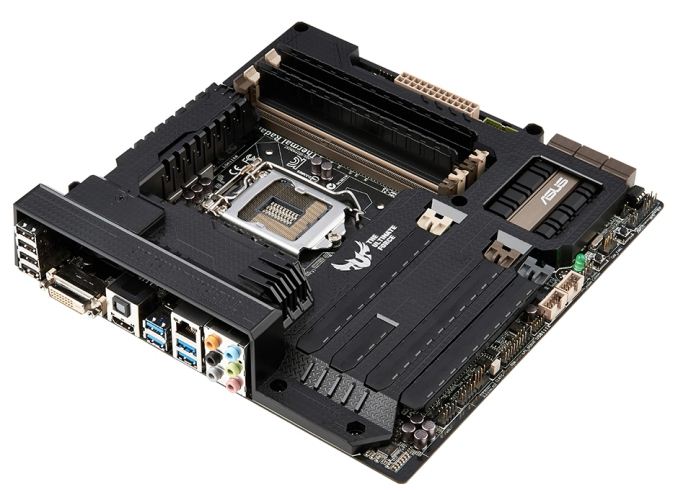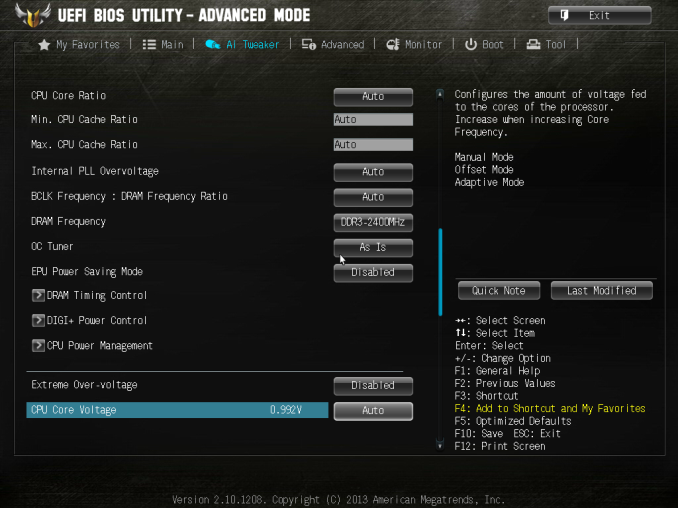ASUS TUF Z87 Gryphon Review
by Ian Cutress on February 3, 2014 10:00 AM EST- Posted in
- Motherboards
- Asus
- Z87
- TUF
ASUS TUF Z87 Gryphon In The Box
Looking back on the original outset of the review, I guess I had no inclination as to what exactly the box of a TUF motherboard would have in it. Given the market for the TUF is towards the longevity and stability of a product, one could argue that safety could be tacked on as well and some form of modified screws with a special screwdriver could be added. Given that the Z87 Gryphon is a ~$162 motherboard, the box contains the following:
Driver DVD
Rear IO Shield
Manuals
Four SATA Cables
Flexi-SLI Bridge
Q-Connectors
Ultimately this is almost the bare minimum ASUS could have put in the box – remove a couple of SATA cables and the SLI bridge would be the minimum compared to what we have seen with lower price segmentation. There is scope here for ASUS to have included something to represent the TUF brand, such as a sticker for a case or a poster. Though I guess what ASUS want users to buy is the Armor Kit, available separately:
ASUS TUF Z87 Gryphon Overclocking
Experience with ASUS TUF Z87 Gryphon
As one might imagine, a motherboard built for stability might not necessarily pull out all the stops to become the best overclocking motherboard on the market. This is probably seen best by the Gryphon’s lack of automatic overclock options – we only found two, and these were further down the overclocking page in the BIOS.
That being said, if ASUS was attempting to escape overclocking, they would have used the H87 chipset. Using some intuition and the manual overclock settings, our CPU still managed to hit the 4.6-4.7 GHz range similar to previous Z87 motherboards we have tested. Motherboards built for longevity and overclocking motherboards are often cut from similar bits of cloth, although the testing applied to either will be different.
Methodology:
Our standard overclocking methodology is as follows. We select the automatic overclock options and test for stability with PovRay and OCCT to simulate high-end workloads. These stability tests aim to catch any immediate causes for memory or CPU errors.
For manual overclocks, based on the information gathered from previous testing, starts off at a nominal voltage and CPU multiplier, and the multiplier is increased until the stability tests are failed. The CPU voltage is increased gradually until the stability tests are passed, and the process repeated until the motherboard reduces the multiplier automatically (due to safety protocol) or the CPU temperature reaches a stupidly high level (100ºC+). Our test bed is not in a case, which should push overclocks higher with fresher (cooler) air.
Automatic Overclock:
The automatic overclock settings are found in the OC Tuner option of AI Tweaker in the BIOS. Selecting this gives two further options to select: Ratio First and BCLK First.
Selecting Ratio First gives a CPU multiplier of 43x/42x/42x/41x, meaning 4.3 GHz in single thread mode down to 4.1 GHz at full load. Over the base CPU turbo, this means an extra 300 MHz on the single thread setting. The BIOS still showed ‘Auto’ for CPU voltages and Load Line Calibrations, and in the OS this gave a load reading of 1.136 volts. PovRay scored 1696.45, and OCCT gave a maximum temperature of 71C. XMP was applied automatically also.
On the BCLK First option, the CPU was adjusted to the 125 MHz strap, giving a 34x125 scenario for all threads, or 4.25 GHz all over. Again the BIOS reported an automatic setting for voltages, although in the OS this meant 1.174 volts during OCCT with a peak temperature of 75C. PovRay scored 1757.7.
Manual Overclock:
For our manual overclock we stayed in the BIOS and started from 4.0 GHz and 1.000 volts. When the system was stable (PovRay + 5 mins OCCT) the multiplier was raised, and for any failure the voltage was raised by +0.025 volts using a fixed voltage application. The following results were achieved:
At 4.7 GHz the system was stable but failing our OCCT temperature tests, giving over 90C. Despite using a TRUE Copper heatsink for this test, better cooling would be needed to push the CPU further.














62 Comments
View All Comments
HandsomeChow - Wednesday, February 12, 2014 - link
No, the outside ambient air will always be cooler than the air inside the case in this scenario. Since fresh cool air is being pulled into the case and heated up and exhausted out the back. When your computer shuts down, the components don't just suddenly cool down to the ambient. It takes time and gradually the heat energy from the components will be transferred to the air inside the case. But if there is no 'Fan Overtime' the hot air will stay inside the case come into contact with the cold case panel and condense into liquid. But with Fan Overtime, the hot air is exhausted out of the case even after shut down.In more humid climates, the air has a higher % of moisture and therefore would cause a even bigger problem since more condensation will occur inside the computer increasing the probability of a component failure.
HaryHr - Tuesday, February 4, 2014 - link
I bought this board for my brother and after initial windows installation problem it is now working in his system with no problems, stable and more than enough for his needs.The problemwe had was when we first tried to install Windows, installation was failing with "could not configure Windows on this computer’s hardware" error.
It was solved by turning off Fast Boot which is default option.
eanazag - Tuesday, February 4, 2014 - link
I really like the POST testing. I think if you video-ed pressing the power button to Windows prompt, then you could get very accurate and consistent measurements.Tig3RStylus - Wednesday, February 5, 2014 - link
I buy Rampage and Maximus boards, but a friend of mine has bought Sabretooth. One pattern that i noticed is the lack of updates available for Sabretooth line when compared to the plethora of updates for Rampage and Maximus. Not a problem in Year 1 or Year 2, but with the TUF lines focus on longevity of 5 years, i wonder if ASUS will step up their commitment and continue to release updates in year 3, 4 and 5. What updates? things like drivers for controllers are not available for Windows 8 on a Sabretooth board thats 2 years old. My friend is going to be upgrading to either Maximus or Rampage next time and ditching the Sabretooth entirely. I doubt he would go near Gryphon with a bargepole for the same reasons. 5 year warranty is useless for anybody who keeps their software and OS up to date if ASUS dont bother providing updates beyond the bare minimum.rigel84 - Thursday, February 6, 2014 - link
Download the drivers from the manufacturer (Intel, VIA, Realtek and so on). If they provide you with an updated BIOS, their job is done.GTVic - Wednesday, February 5, 2014 - link
I like the complete absence of all legacy ports, including PS/2.YukaKun - Thursday, February 6, 2014 - link
Great Mobo, but just an ALC892? For REAL? At least go for the ALC1150 or a SupremeFX or your own Sonar line for this great MoBo.You dropped the ball there, Asus.
Cheers!
HandsomeChow - Wednesday, February 12, 2014 - link
Just a quicktip, you know the OEM shielding on the SupremeFX is bollocks right? The fact that it is shielded doesn't mean it is not prone to sound interference, if you can see it physically, sound can get to it.DMCalloway - Friday, February 7, 2014 - link
Four days have gone by and still nothing new here........ReneGQ - Thursday, March 13, 2014 - link
I recently purchased an Asus Motherboard and the problems started from day 1. The drivers update never works, the same for AI Suite III (there´s a lot of updates for this model in Asus webpage). After 2 months I still can´t install BitDefender cause a clock watchdog error.Asus technical support is the worst, mails comes and goes with no solution.
I will not recommend this brand to anyone. The brand has a very good Marketing but the product and the service are very disappointment.